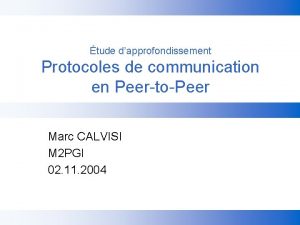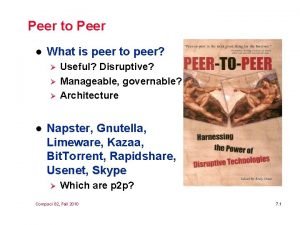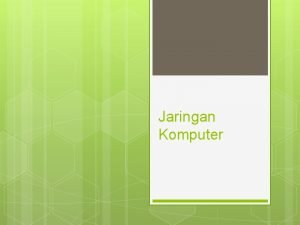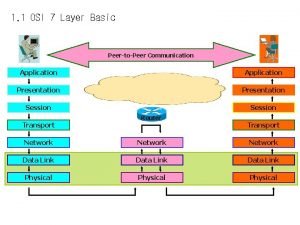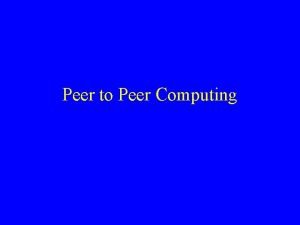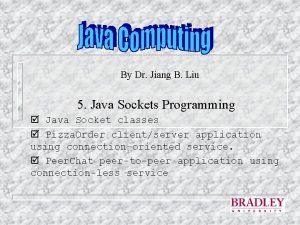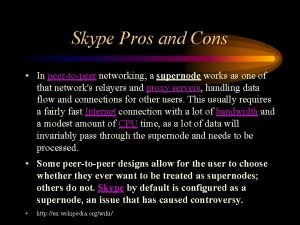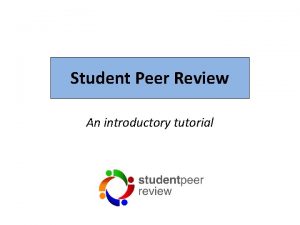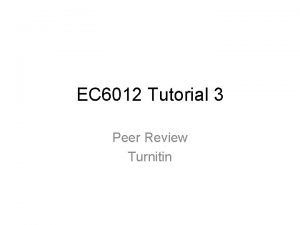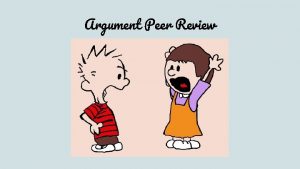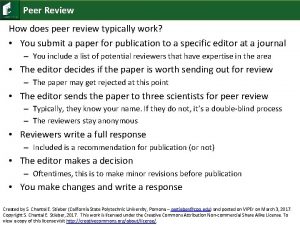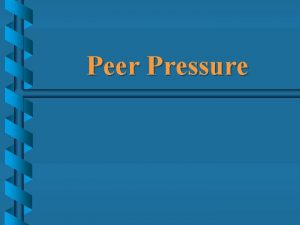Student Peer Review An introductory tutorial The peer

























- Slides: 25

Student Peer Review An introductory tutorial

The peer review process Conduct study Write manuscript Submit to journal Peer review Accept Revise Reject

What is student peer review? Students give & receive feedback on each other’s work Use feedback to improve assignment before final assessment Objectives: ü Critically evaluate ü Highlight strengths & weaknesses ü Offer suggestions for improvement

How does it work? Step 1: Prepare & submit a draft copy of assignment Step 2: Review 1 -3 assignments Step 3: Receive feedback on own assignment Step 4: Incorporate feedback & submit final assignment Process is “double blind” to ensure fairness

What are the benefits? ü Feedback before assessment allowing time to improve ü Get insights into your own work by reviewing other assignments ü Learn from comparison by seeing other students’ work ü Improve understanding of subject matter ü Develop generic skills – Critical thinking – Problem solving – Delivering constructive feedback

Assignment details • Assignment type • Number of reviews to write • Number of reviews to receive • Review feedback: – Letter to the Editor – Rating feedback

Writing a review When writing a review: • Aim for balance – highlight strengths as well as areas for improvement • Be specific – include explanations & examples (page or line numbers) • Prioritise – attend major issues first (message, structure, organisation) then move onto finer detail • Focus – on material & content (NOT the writer) • Be diligent & respectful – take care & think about how you would feel if you received the review

Helpful vs. unhelpful feedback Helpful feedback is: Unhelpful feedback is: ü Constructive Too positive or too negative ü Specific ü Balanced ü Succinct ü Respectful vs. General & unspecific Rambling Aggressive – makes reader feel ‘attacked’

Helpful vs. unhelpful feedback 1. What are the main strengths of this report? Unhelpful comment: “Your report was really good! I enjoyed reading it. ” Author’s response: “I’m flattered you liked my report, but I don’t have a sense of what you thought was good about it. ” ü Helpful comment: “This report was succinct and well written. The aims of the report were clear and I found it easy to identify your takehome messages. . . ”

Helpful vs. unhelpful feedback 2. Where are the main areas for improvement? Unhelpful comment: “Your report was poorly written and hard to read!” Author’s response: “This comment doesn’t really help me to improve anything!” ü Helpful comment: “There a few areas that might make this report stronger. Expanding the Introduction to include more background information would help set the scene a little more (para 2). The arguments could also be strengthened by adding additional references, for examples lines 3, 16 and 55. . . ”

Helpful vs. unhelpful feedback 3 a. Is the balance between the sections about right? Unhelpful comment: “No – there wasn’t enough space left for covering the background of the study. ” ü Helpful comment: “The balance feels very good; however you may consider the possibility of expanding the background section with greater information on theoretical concepts being tested” Author’s response: “Although stating good and bad points, none of it was portrayed negatively. The comments were given helpfully, with clear points for me to follow. ”

Helpful vs. unhelpful feedback 3 b. Is the balance between the sections about right? Unhelpful comment: “The overall balance was good, with no section out-weighing any other at all. ” Author’s response: “Very positive review, but not much given that I can improve on - I highly doubt it was almost perfect. ” ü Helpful comment: “Not the best balance: The introduction and rationale sections were too lengthy. While very clear, they could be trimmed down quite a bit and made to be much more concise. For example, I think lines 108 to 113 are unnecessary. . . ”

Helpful vs. unhelpful feedback 4 a. Did you feel the article had good flow and structure? Unhelpful comment: “The paper flows really well from one section to the next and there is a logical progression. ” ü Helpful comment: “It had good flow and structure from paragraphs 1 -5, but somewhat lost it’s flow from then on. This can be fixed by adjusting the order in which you present your points. For instance, in paragraph 2. . . ” Author’s comment: “Thanks for this comment – it was a good mix of positive comments and suggestions for improvement. It was insightful and helped me improve my paper. ”

Helpful vs. unhelpful feedback 4 b. Did you feel the article had good flow and structure? Unhelpful comment: “The article flowed really nicely and it was easy to follow the author’s train of thought” ü Helpful comment: “Not the best balance: The introduction and rationale sections were too lengthy. While very clear, they could be trimmed down quite a bit and made to be much more concise. For example, I think lines 108 to 113 are unnecessary. . . ” Author’s comment: “This comment is much more helpful because it gives me specific areas I can improve. ”

Example review 1 “I like the writing style, and I think the Specific? article is relatively easy to follow and the paragraphs are well linked. The article Constructive? might be stronger if some of the sentences were more simple and succinct such as line 1 and 7 in paragraph 1, and line 3 in paragraph 4. ” Balanced? Clear?

Example review 2 “This paper has poor structure and flow. There are several grammatical and spelling errors and some of the paragraphs should be shortened. I Specific? Constructive? Balanced? got confused about what you were trying to say at some points. ” Clear?

Example review 3 “Some sentences lacked commas where Specific? there should have been one, or were too long at times (e. g. line 34 and line 41). Otherwise, the article as a whole had a smooth flow and the intent behind each paragraph clear and understandable. ” Constructive? Balanced? Clear?

The review form Review questions are aligned with assessment criteria:

Time management ONE WEEK TURNAROUND º Read manuscript (thoroughly) = 0. 5 hr º Annotate / make notes = 0. 5 hr º Decide on the good / bad points º Complete “Review Form” = 0. 5 – 1 hr The quality of the review will be time-dependent

Writing a review: summary ü Read the draft thoroughly ü Annotate/make notes ü Decide on the strengths/areas for improvement ü Complete review form ü Be specific, constructive & balanced ü Proof-read review!

Receiving feedback When you receive a review: • Understand that reviews will vary in quality • Take time to gather your thoughts & digest the comments • Think about every comment – even if you disagree, consider if it will be an issue for other readers • Recognise the review as an opportunity for reflection & improvement

Receiving feedback: tips ü Don’t panic! ü Read all the comments & make notes ü Take time to reflect ü Address major issues ü Tackle smaller points ü Proof-read final document

Responding to reviewers Rate the reviews you have received along a scale (strongly disagree to strongly agree) according to: ü Balance – did the review both highlight strengths & suggest areas for improvement? ü Insight – did the review point out things you hadn’t thought of? ü Helpfulness – did the review contain specific suggestions you were able to implement? ü Authoritativeness – was it clear this reviewer knew their stuff? ü Clarity – was the review well-written and easy to understand?

Technical notes • Before submitting your assignment, ensure it: – Is in a common file format (e. g. PDF) – Has continuous line numbers (will help reviewers point to particular areas – Is as polished and complete as possible (will lead to more effective feedback) • How to access PRAZE/online forms

Questions?
 Medaccred furnace
Medaccred furnace Annotazioni sulla verifica effettuata peer to peer
Annotazioni sulla verifica effettuata peer to peer Peer-to-peer
Peer-to-peer Peer to peer transactional replication
Peer to peer transactional replication Peer to peer transactional replication
Peer to peer transactional replication Gambar topologi peer to peer
Gambar topologi peer to peer Esempio registro peer to peer compilato
Esempio registro peer to peer compilato Esempi di peer to peer compilati
Esempi di peer to peer compilati Relazione finale tutor tirocinio esempio
Relazione finale tutor tirocinio esempio Peer to peer l
Peer to peer l Peer to peer merupakan jenis jaringan… *
Peer to peer merupakan jenis jaringan… * Bitcoin: a peer-to-peer electronic cash system
Bitcoin: a peer-to-peer electronic cash system Features of peer to peer network and client server network
Features of peer to peer network and client server network Programmazione e sviluppo condiviso peer to peer
Programmazione e sviluppo condiviso peer to peer Peer-to-peer communication in osi model
Peer-to-peer communication in osi model Peer p
Peer p Node lookup in peer to peer network
Node lookup in peer to peer network Peer-to-peer o que é
Peer-to-peer o que é Peer to peer computing environment
Peer to peer computing environment Peer to peer intervention
Peer to peer intervention Peer-to-peer o que é
Peer-to-peer o que é Peer-to-peer o que é
Peer-to-peer o que é Peer to peer network hardware
Peer to peer network hardware Peer to peer chat application in java
Peer to peer chat application in java Skype reviews pros and cons
Skype reviews pros and cons Jaringan peer to peer diistilahkan dengan
Jaringan peer to peer diistilahkan dengan


